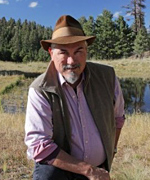 —Alan Dulaney
—Alan Dulaney
Lots of things that were predicted to happen in 2017, didn’t. The drought didn’t end (ignore what California thinks). Lake Mead didn’t fall below water level elevations that would have triggered a shortage declaration. The much-negotiated Drought Contingency Plan for the Lower Basin states on the Colorado River didn’t happen. The prerequisite DCP Plus agreement for Arizona didn’t happen either, largely due to agricultural, municipal, and tribal interests getting stubborn about what they want out of it, although the ongoing feud between CAP and ADWR definitely contributed to the lack of progress. Speaking of CAP affairs, the much-anticipated Ninth Circuit decision on CAWCD’s claim of sovereign immunity didn’t happen either, mostly because CAWCD hurriedly backed out of the court proceedings when they saw which way the decision was likely to go. ADEQ didn’t find lead concentrations exceeding MCLs in over 96% of Arizona school fixtures (like drinking fountains), based on over 16,000 samples.
Things that did happen were mostly good. Lake Mead water elevations didn’t fall below trigger levels because CAWCD led the system conservation effort that parked a considerable volume of water in the lake, enough to slow the decline. Agricultural, municipal, and tribal contributions played a big role in that success, in terms of both water and money. Yes, they can cooperate. Minute 323 was signed by Mexico and the United States, which will help the Colorado River. And the Senate confirmed a new Commissioner for the Bureau of Reclamation, Brenda Burman, with Arizona experience and a thorough understanding of Western water issues.
What lies in wait for 2018? The Arizona Legislature seems more chaotic than usual, with members looking around to see what recently vacated state or federal office might be worth a run. Several bills related to water will be dropped, or maybe just one big bill that special interests will try to carve up into smaller pieces. Everyone awaits the actual language (and the name of the sponsor) with baited breath. Much of the legislation will have stemmed from the contentious Governor’s Water Discussions that occurred through 2017. Groundwater regulation outside the Active Management Areas and Colorado River issues will be the two major foci. Once launched down the slope, there is no telling where the Legislature will wind up. The legislative agenda will be much more clear by February, but the personnel shifts won’t.
On the agency level, ADEQ is wrapping up rules on reclaimed water. This will include recognition that direct potable reuse is a necessary part of Arizona’s water future. ADWR has been hiring staff, but even more will be needed if they get new mandates to track groundwater withdrawals and water level changes outside the AMAs. Where will that money come from?
And when will it begin to rain?